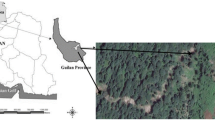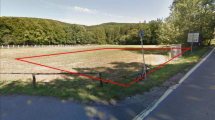Abstract
The epikarst together with its soil stocks (subcutaneous structure) are crucial to the fact that they may contribute to the canopy growth and can significantly influence the ecological restoration and organic carbon sequestration. Geophysical techniques especially, the ground penetrating radar (GPR) are advantageous for such investigations. However, the complicated karst environment due to numerous influencing factors (i.e., the forest, epikarst slope, peak-cluster depression, soil humidity, high voltage power lines) can significantly influence the exploration with GPR. In the past, such applications were limited to local scales without considering the aforementioned factors together. Hence, the present study analyses the influences of these factors on the performance and reliability of GPR results considering the central Guizhou plateau of south-west China as a case study. These site-specific findings are summarized into a GPR application potential zonation map at the catchment scale. The zones were rated as low, moderate and high potential degree regions, each reflecting results reliability which can be considered as a cost-effective feasibility reference for the future GPR applications in complex karst terrain characterization, as well as the areas having similar karstic conditions.

















Similar content being viewed by others
Data availability
The datasets in this study are available from the corresponding author upon reasonable request.
References
Alani AM, Lantini L (2020) Recent advances in tree root mapping and assessment using non-destructive testing methods: a focus on ground penetrating radar. Surv Geophys 41:605–646. https://doi.org/10.1007/s10712-019-09548-6
Al-fares W, Bakalowicz M, Guérin R, Dukhan M (2002) Analysis of the karst aquifer structure of the Lamalou area (Hérault, France) with ground penetrating radar. J Appl Geophys 51:97–106. https://doi.org/10.1016/S0926-9851(02)00215-X
Bahorich M, Farmer S (1995) 3-D seismic discontinuity for faults and stratigraphic features: The coherence cube. Lead Edge 14:1053–1058. https://doi.org/10.1190/1.1437077
Barna JM, Fryar AE, Cao L et al (2020) Variability in groundwater flow and chemistry in the Houzhai Karst Basin, Guizhou Province, China. Environ Eng Geosci 26:273–289. https://doi.org/10.2113/EEG-2306
Brandt M, Yue Y, Wigneron JP et al (2018) Satellite-observed major greening and biomass increase in South China karst during recent decade. Earth’s Future 6:1017–1028. https://doi.org/10.1029/2018EF000890
Campbell JE (1990) Dielectric properties and influence of conductivity in soils at one to fifty megahertz. Soil Sci Soc Am J 54(2):332–341. https://doi.org/10.2136/sssaj1990.03615995005400020006x
Carbonel D, Rodríguez V, Gutiérrez F et al (2014) Evaluation of trenching, ground penetrating radar (GPR) and electrical resistivity tomography (ERT) for sinkhole characterization. Earth Surf Proc Land 39:214–227. https://doi.org/10.1002/esp.3440
Carcione JM, Seriani GS, Gei D (2003) Acoustic and electromagnetic properties of soils saturated with salt water and NAPL. J Appl Geophys 52:177–191. https://doi.org/10.1016/S0926-9851(03)00012-0
Čeru T, Šegina E, Knez M et al (2018) Detecting and characterizing unroofed caves by ground penetrating radar. Geomorphology 303:524–539. https://doi.org/10.1016/j.geomorph.2017.11.004
Chen H, Fu W, Wang K et al (2006) Dynamic change of soil water in peak-cluster depression areas of Karst Mountainous Region in Northwest Guangxi. Bull Soil Water Conserv 20:136–139. https://doi.org/10.13870/j.cnki.stbcxb.2006.04.033. (in Chinese)
Cheng J, Pan D, Li W et al (2010) Study on the detecting of hazard abandoned workings by ground penetrating radar on strong electromagenetic interference area. J China Coal Soc 35(2):227–231. https://doi.org/10.1322/j.cnki.jccs.2010.02.017. (in Chinese)
Cheng Q, Tao M, Chen X et al (2019) Evaluation of electrical resistivity tomography (ERT) for mapping the soil–rock interface in karstic environments. Environ Earth Sci 78:1–14. https://doi.org/10.1007/s12665-019-8440-8
Cheng Q, Wang S et al (2020) Sediment sources, soil loss rates and sediment yields in a Karst plateau catchment in Southwest China. Agr Ecosyst Environ 304:107114. https://doi.org/10.1016/j.agee.2020.107114
Coulouma G, Samyn K, Grandjean G et al (2012) Combining seismic and electric methods for predicting bedrock depth along a Mediterranean soil toposequence. Geoderma 170:39–47. https://doi.org/10.1016/j.geoderma.2011.11.015
Desper DB, Link CA, Nelson PN (2015) Accurate water-table depth estimation using seismic refraction in areas of rapidly varying subsurface conditions. Near Surf Geophys 13:455–465. https://doi.org/10.3997/1873-0604.2015039
Ding W, We Wu, Wang C, Wu Z (2014) Propagation characteristics of seismic waves in shallow soil with the unsaturated three-phase poroelastic model. Acta Phys Sin 63:224301. https://doi.org/10.7498/aps.63.224301. (in Chinese)
Doolittle JA, Collins ME (1998) A comparison of EM induction and GPR methods in areas of karst. Geoderma 85:83–102. https://doi.org/10.1016/S0016-7061(98)00012-3
Doolittle JA, Minzenmayer FE, Waltman SW, Benham EC (2003) Ground penetrating radar soil suitability maps. J Environ Eng Geophys 8:49–56. https://doi.org/10.4133/JEEG8.2.49
Doolittle JA, Minzenmayer FE, Waltman SW et al (2007) Ground-penetrating radar soil suitability map of the conterminous United States. Geoderma 141:416–421. https://doi.org/10.1016/j.geoderma.2007.05.015
Doolittle J, Dobos R, Peaslee S et al (2010) Revised ground-penetrating radar soil suitability maps. J Environ Eng Geophys 15:111–118. https://doi.org/10.2113/JEEG15.3.111
dos Reis JA, de Castro DL, de Jesus TES, Filho FPL (2014) Characterization of collapsed paleocave systems using GPR attributes. J Appl Geophys 103:43–56. https://doi.org/10.1016/j.jappgeo.2014.01.007
Gao Q, Wang S, Peng T et al (2020) Evaluating the structure characteristics of epikarst at a typical peak cluster depression in Guizhou plateau area using ground penetrating radar attributes. Geomorphology 364:107015. https://doi.org/10.1016/j.geomorph.2019.107015
Gao Q, Hussain Y, Yang T (2022) Analysis of georadar responses on environmentally significant karst landform. PREPRINT (Version 1) available at Research Square. https://doi.org/10.21203/rs.3.rs-2290108/v1
Gizzi FT, Leucci G (2018) Global research patterns on ground penetrating radar (GPR). Surv Geophys 39:1039–1068. https://doi.org/10.1007/s10712-018-9475-1
Guo S, Zhu J, Wang C et al (2021) Study on the joint application of electrical and seismic exploration in the investigation of fissure and Karst cave in Fuling area. CT Theory Appl 30:49–59. https://doi.org/10.15953/j.1004-4140.2021.30.01.05.(inChinese)
Han X, Liu J, Zhang J, Zhang Z (2016) Identifying soil structure along headwater hillslopes using ground penetrating radar based technique. J Mt Sci 13:405–415. https://doi.org/10.1007/s11629-014-3279-7
Hussain Y, Rogerio U, Welitom B et al (2020) The potential use of geophysical methods to identify cavities, sinkholes and pathways for water infiltration. Water 12:2289. https://doi.org/10.3390/w12082289
Hussain Y, Seivane H, Gao Q et al (2023) Seismic signatures and site characterization of an intermittent stream in dry and flood conditions: an implication for soil losses and landslide triggering. Environ Earth Sci 82:295. https://doi.org/10.1007/s12665-023-10960-w
Johnson RW, Glaccum R, Wojtasinski R (1979) Application of ground penetrating radar to soil survey. Soil Crop Sci Soc Florida Proc 39:68–72
Jol HM (2009) Ground penetrating radar: theory and applications. Elsevier Science, Amsterdam
Li S, Liu C, Li J et al (2010) Geochemistry of dissolved inorganic carbon and carbonate weathering in a small typical karstic catchment of Southwest China: isotopic and chemical constraints. Chem Geol 277:301–309. https://doi.org/10.1016/j.chemgeo.2010.08.013
Li L, Xia Y, Liu S et al (2015) Modified method for estimating organic carbon density in discontinuous Karst soil using ground-penetrating radar and geostatistics. J Mt Sci 12:1229–1240. https://doi.org/10.1007/s11629-015-3431-z
Pasquet S, Bodet L, Bergamo P et al (2016) Small-scale seismic monitoring of varying water levels in granular media. Vadose Zone J 15:1–14. https://doi.org/10.2136/vzj2015.11.0142
Schellentrager GW, Doolittle JA, Calhoun TE, Wettstein CA (1988) Using ground-penetrating radar to update soil survey information. Soil Sci Soc Am J 52:746–752. https://doi.org/10.2136/sssaj1988.03615995005200030027x
Šumanovac F, Weisser M (2001) Evaluation of resistivity and seismic methods for hydrogeological mapping in karst terrains. J Appl Geophys 47:13–28. https://doi.org/10.1016/S0926-9851(01)00044-1
Tao M, Chen X, Cheng Q, Binley A (2022) Evaluating the joint use of GPR and ERT on mapping shallow subsurface features of karst critical zone in southwest China. Vadose Zone J. https://doi.org/10.1002/vzj2.20172
Tardío G, González-Ollauri A, Mickovski SB (2016) A non-invasive preferential root distribution analysis methodology from a slope stability approach. Ecol Eng 97:46–57. https://doi.org/10.1016/j.ecoleng.2016.08.005
Tong X, Brandt M, Yue Y et al (2018) Increased vegetation growth and carbon stock in China karst via ecological engineering. Nat Sustain 1:44–50. https://doi.org/10.1038/s41893-017-0004-x
Valois R, Camerlynck C, Dhemaied A et al (2011) Assessment of doline geometry using geophysics on the Quercy plateau karst (South France). Earth Surf Proc Land 36:1183–1192. https://doi.org/10.1002/esp.2144
Yan D, Zhang X, Wen A et al (2012) Assessment of sediment yield in a small karst catchment by using 137Cs tracer technique. Int J Sedim Res 27:547–554. https://doi.org/10.1016/S1001-6279(13)60012-8
Yang J, Zhang C (2014) Earth’s critical zone: a holistic frame for geo-environment researches. Hydrgeology & Engineering Geology 41:98–104, 110. https://doi.org/10.16030/j.cnki.issn.1000-3665.2014.03.012. (in Chinese)
Yang J, Chen H, Nie Y, Wang K (2019) Dynamic variations in profile soil water on karst hillslopes in Southwest China. CATENA 172:655–663. https://doi.org/10.1016/j.catena.2018.09.032
Zajícová K, Chuman T (2019) Application of ground penetrating radar methods in soil studies: a review. Geoderma 343:116–129. https://doi.org/10.1016/j.geoderma.2019.02.024
Zhang Z, Chen X, Cheng Q et al (2011) Hydrogeology of epikarst in karst mountains—a case study of the Chenqi catchment. Earth Environ 39:19–25. https://doi.org/10.14050/j.cnki.1672-9250.2011.01.016. (in Chinese)
Zhang C, Qi X, Wang K et al (2017) The application of geospatial techniques in monitoring karst vegetation recovery in southwest China: a review. Prog Phys Geogr 41:450–477. https://doi.org/10.1177/0309133317714246
Zhang Z, Zhou Y, Wang S et al (2018) Change in SOC content in a small karst basin for the past 35 years and its influencing factors. Arch Agron Soil Sci 64:2019–2029. https://doi.org/10.1080/03650340.2018.1474520
Zhao W, Forte E, Pipan M et al (2013) Ground penetrating radar (GPR) attribute analysis for archaeological prospection. J Appl Geophys 97:107–117. https://doi.org/10.1016/j.jappgeo.2013.04.010
Zhou J, Tang Y, Yang P et al (2012) Inference of creep mechanism in underground soil loss of karst conduits I. Concept Model Nat Haz 62:1191–1215. https://doi.org/10.1007/s11069-012-0143-3
Acknowledgements
We thank two anonymous reviewers for the constructive and professional reviews and comments that improved this manuscript.
Funding
The authors have not disclosed any funding.
Author information
Authors and Affiliations
Contributions
QG wrote the original manuscript and did most work. YH improved the manuscript and discussed many contents. LC mapped some figures and participated filed work. DC gave some key ideas and discussions.
Corresponding author
Ethics declarations
Conflict of interest
The authors declare no competing interests.
Additional information
Publisher's Note
Springer Nature remains neutral with regard to jurisdictional claims in published maps and institutional affiliations.
Supplementary Information
Below is the link to the electronic supplementary material.
Rights and permissions
Springer Nature or its licensor (e.g. a society or other partner) holds exclusive rights to this article under a publishing agreement with the author(s) or other rightsholder(s); author self-archiving of the accepted manuscript version of this article is solely governed by the terms of such publishing agreement and applicable law.
About this article
Cite this article
Gao, Q., Hussain, Y., Cao, L. et al. A catchment scale GPR application potential zonation: case study from SW China. Environ Earth Sci 82, 514 (2023). https://doi.org/10.1007/s12665-023-11200-x
Received:
Accepted:
Published:
DOI: https://doi.org/10.1007/s12665-023-11200-x




